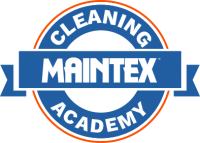Instructions
Always wear personal protective equipment when handling chemicals. Wear gloves when spotting carpet. Review the product labels and chemical SDS. When using a pump sprayer it must be properly labeled.
Prepare the floor

A
Remove furniture and fixtures, then detail vacuum the carpet, paying special attention to corners and edges.
TIP: While you are vacuuming, take note of heavily soiled areas that may require special attention.

B
Dilute the pre-spray into the pump sprayer according to label directions.

C
Place Wet Floor signs blocking off the carpeted area to be cleaned.
Restorative care process

1
Fill the extractor solution tank with warm water and add Last Step Carpet Rinse according to the label.

2
Add one ounce of defoamer to the recovery tank.

3
Pre-spray traffic lanes and heavily soiled areas, then brush the pre-spray onto the surface with a carpet brush or carpet rake.

4
Treat spots and stains with carpet spotter.

5
Allow the products to dwell for at least 5 minutes.

6
Plug in the extractor and adjust the handle. Beginning at the point farthest from the exit, turn on the power and engage the pump and vacuum brush mode.

7
Clean the carpet by squeezing the solution trigger while slowly pulling back in a straight path.

8
Release the solution trigger several feet before reaching the end of each cleaned path and continue pulling machine to pick up the excess solution.

9
Tip the extractor back on the rear tilt wheels and push the machine forward to the beginning of the next area to clean, overlapping each path by a few inches.

10
After a few passes, check your recovery tank. If there is excess foam, add more defoamer. When the water pickup stops or the recovery tank becomes full, unplug the power cord and empty the recovery tank. Add more defoamer to the recovery tank and more solution to the solution tank, then continue cleaning.

11
Traffic lanes and heavily soiled areas may require extra care. In those areas, clean with several repeated passes with the brushes without adding solution. This allows you to operate only the brush without over-wetting the carpet.

12
Use air movers to dry the carpet for 3-4 hours. In large areas, multiple air movers may be required.

13
Once the carpet is completely dry, remove the wet floor signs and return furnishings to their original positions.

14
When you are finished, empty and rinse the extractor tanks, clean the brushes, and wipe down the machine. Rinse out the pump sprayer. Return your supplies to the cleaning supply area.
Knowledge Quiz
Restorative Carpet Care
Restorative Carpet Care
True or False: Effective carpet care involves daily cleaning, interim maintenance, and annual restorative care.
A three-pronged carpet care program will prolong the life of the carpet and enhance the image of your facility. Restorative cleaning is the process that renews visibly soiled and dingy carpet. It is typically performed once annually.
True or False: The extraction process will vary depending on which type of extractor you use.
The extraction process remains the same regardless of which type of extractor you use. Your Maintex representative can help you select the correct model for your needs.
True or False: Before beginning the extraction process, you should perform a detail vacuum using a powerful, high quality vacuum.
Detail vacuuming the entire area will removes the surface dust and grit. Remember to inspect the area for heavily trafficked wear conditions and spots.
After vacuuming and preparation, what is the first step in the extraction process?
After placing wet floor signs and putting on PPE, dilute First Step pre-spray into a large pump sprayer and apply to soiled areas. Agitate the surface with a carpet brush or rake.
After pre-spraying the carpet, what is the next step?
Treat any visible spots and stains by spraying carpet spotter directly onto the stain. Let the product dwell for at least 5 minutes.
After treating spots and stains, what is the next step?
Use the extractor to thoroughly clean, rinse, and vacuum the carpet. When you are finished, use air movers to accelerate the drying process.
Which chemical should be added to the carpet extractor’s solution tank?
Add warm water to the carpet extractor’s solution tank, then add Last Step Carpet Rinse according to label directions.
True or False: Defoamer added to the recovery tank prevents foam from damaging the extractor vacuum motor.
Begin with one ounce of defoamer in the recovery tank. After a few passes, check for excess foam and add more defoamer if needed.
When using an extractor to clean carpeted floors, where in the room should you start the process?
Always clean from the point farthest from the exit. You do not want to walk over damp carpet.
When operating a walk-behind extractor, which of the following is NOT true?
Operate the extractor by pulling it towards you. This way you avoid walking on wet carpet and the vacuum shoe can properly extract liquid and debris.
Restorative Carpet Care
Featured Products

Upright Vacuum

Wet Floor Sign

2 Gallon Pump Sprayer

Air Mover

Carpet Rake

Measuring Cup

Extension Cord

First Step Carpet Pre-Spray

Last Step Carpet Rinse

Anti-Foam Defoamer

Oxy Citrus Peroxide Cleaner

Tennant E5 Low-Profile Extractor
Carpet Care

Daily Carpet Cleaning
Properly maintaining your facility’s carpeted areas on a daily basis will protect and extend the life of the carpet, enhance the appearance, and improve indoor air quality.

Interim Carpet Maintenance
Interim maintenance is an important component of extending the life and beauty of carpet.

Restorative Carpet Care
Restorative cleaning is a process that renews visibly soiled and dingy carpet to enhance the image of any facility.







